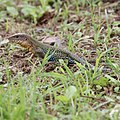| Image | Name | Distribution |
|---|
| Ameiva aggerecusans Koch, Venegas, Rödder, Flecks & Böhme, 2013 | Peru |
 | Ameiva ameiva (Linnaeus, 1758) – giant ameiva, green ameiva, South American ground lizard, Amazon racerunner | Central, South America, and some Caribbean Islands. |
 | Ameiva atrigularis (Garman, 1887) – giant ameiva, Amazon racerunner | Trinidad and Tobago and in Venezuela. |
| Ameiva bifrontata Cope, 1862 – Cope's ameiva | Peru, Colombia, Venezuela, Netherlands Antilles, and Aruba. |
| Ameiva concolor (Ruthven, 1924) | Peru. |
 | Ameiva fuliginosa (Cope, 1892) | Isla de Providencia, San Andrés, and the Swan Islands. |
| Ameiva jacuba Giugliano, Nogueira, Valdujo, Collevatti & Colli, 2013 | Brazil. |
| Ameiva nodam Koch, Venegas, Rödder, Flecks & Böhme, 2013 | Peru. |
| Ameiva pantherina Ugueto & Harvey, 2011 | Venezuela. |
| Ameiva parecis (Colli, Costa, Garda, Kopp, Mesquita, Péres, Valdujo, Vieira & Wiederhecker, 2003) | Brazil. |
 | Ameiva praesignis (Baird & Girard, 1852) – giant ameiva, Amazon racerunner | Costa Rica, Panama, Venezuela, and Colombia. |
| Ameiva provitaae García-Pérez, 1995 | Venezuela. |
| Ameiva reticulata Landauro, Garcia-Bravo & Venegas, 2015 | Peru. |
 | Ameiva tobagana Cope, 1879 – Antillean ameiva | Grenada and St. Vincent. |
|





